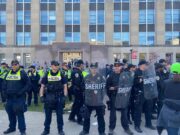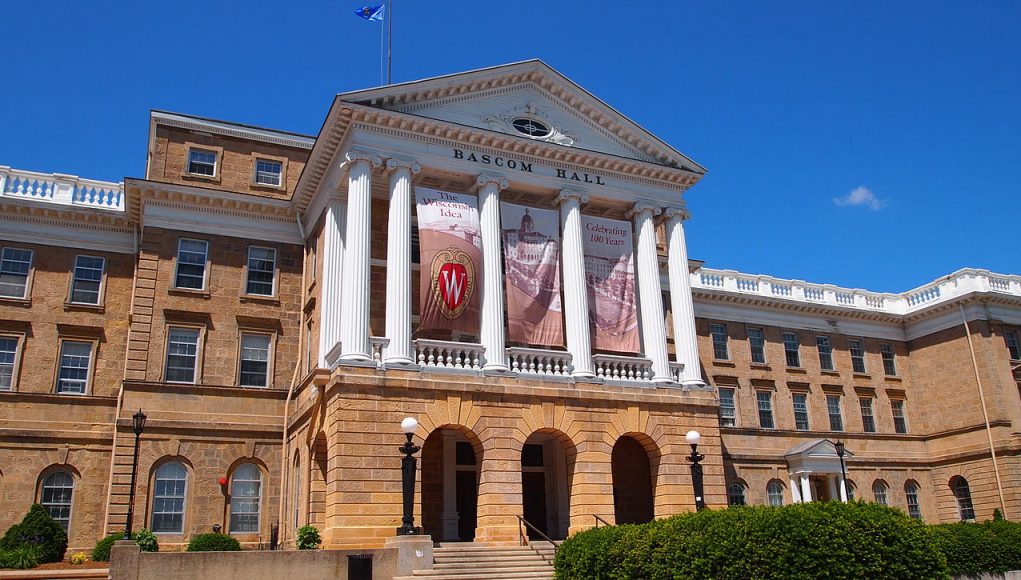Like many black UW alumni across the country, I was startled to see a photo pop up on my Facebook news feed late last fall from a football game at Camp Randall Stadium where someone in the stands dressed as Donald Trump had a rope around the neck of another person in a Barack Obama mask. They had been caught on camera depicting Trump lynching Obama and Clinton. Photos and video of this incident quickly went viral, and all eyes were on Wisconsin to see how the university would respond.
Instead of requiring the perpetrators to leave the stadium, Camp Randall officials only asked them to remove the rope and masks. They later repeated the offense while walking around in the stadium. Nearly 10 days later, UW Chancellor Rebecca Blank announced that four season tickets were being revoked from two groups of fans who were believed to be involved in the incident. It was way too little and way too late. Black leaders in the Madison community, athletes and students alike were all outraged with the university’s lackluster initial response. But the emotion that was missing was shock.
“As a UW alumna, I look back on my time at the university not as something I remember fondly, but as something I got through. I graduated with distinction with a master’s degree in educational administration for higher education. I had only ONE faculty member of color in a counseling psychology elective. It amazed me how a department that was dedicated to training educators and administrators at the college level could so poorly reflect the changing demographics in that environment.”
It’s like a bad movie that keeps playing on a loop. An act of overt racial aggression happens on the campus of a predominately white institution (PWI). The administration offers up a tepid response that clearly demonstrates not only a lack of preparedness, but also indicates more concern for the feelings of the perpetrators than the impact on the intended victims. Cue outrage from local and national sources. After being publicly dragged, an institutional figurehead apologizes, promises that the incident is being reviewed, and pledges to find solutions – all while swearing that his or her school values an inclusive environment.
What does that mean? No college can guarantee that it will be able to identify and weed out all racists and bigots in the admissions process, so they will never have the opportunity to act out on campus. Nor is there a way to screen out racist fans who show up at campus events. However, universities have to be held accountable for ignoring race relations on their campuses and in the communities of which they are a part until they boil over into incidents like the one in Camp Randall. When UW tripped over itself in its response, that sent a clear message to students and alumni of color and people in the surrounding area that, despite several widely publicized racist incidents at multiple institutions across the country, the administration did not consider it a priority until it was forced to.
Instead of giving lip service to the idea of inclusivity on campus, PWIs should engage with their diverse student populations. Inclusivity can only begin with a willingness to listen to and understand how students of color experience their institutions. Recently, a collective of Black UW-Madison alumni and their allies presented the university with a set of recommendations that seek to address the racially hostile environment that many alumni experienced during their time as UW students and that has persisted for current students of color.
As a UW alumna, I look back on my time at the university not as something I remember fondly, but as something I got through. I graduated with distinction with a master’s degree in educational administration for higher education. I had only ONE faculty member of color in a counseling psychology elective. It amazed me how a department that was dedicated to training educators and administrators at the college level could so poorly reflect the changing demographics in that environment. We never spoke of diversity, save for the one class on the subject that my mentor taught. Understanding culture in our own classrooms was not a priority.
UW has made some strides with its Problem with Whiteness course and the Men’s Project. Both are examples of efforts to foster open dialogue on racism, sexism, homophobia and sexual violence. Acknowledging systemic oppression and encouraging students to engage in conversations about the cultural “norms” that perpetuate them is an encouraging step. However, more needs to be done. It’s not enough for the university to foster on-campus conversations, but then be caught unaware and unprepared when something like the noose incident happens.
Making meaningful change is not just the responsibility of students and a few faculty members. A larger and deeper commitment is needed at the administrative level so that a message is sent to all students that the UW is a place where they are valued and can trust that their institution is doing the real work it takes to foster an inclusive environment.




























